insight
How does payroll tax reporting work with a PEO?
Professional Employer Organizations (PEOs) simplify payroll tax reporting for small and midsized businesses. In a PEO relationship, the PEO becomes responsible for federal, state, and local payroll tax withholding and remittance. The expertise and ongoing support provided by a PEO gives businesses the confidence that their payroll taxes are handled accurately and efficiently, and thus the room to focus more intently on their core operations.
In a PEO relationship, state income tax reporting is typically done at the PEO level (under the PEO’s tax ID, since the PEO is considered the employer of record). However, state unemployment tax reporting differs and can vary by state, as some states require it to be filed under the client’s own account, and others allow or require it to be filed under the PEO’s account.
Table of Contents

PEO vs. Client Reporting States
The core difference between PEO-reporting states, client-reporting states, and mixed reporting states is who is defined as the employer of record for certain state taxes. In PEO reporting states, the PEO is identified as the employer of record and uses its own Employee Identification Number (EIN) for tax filing and reporting. In client-reporting states, the client remains employer of record and although the PEO manages the reporting, the reporting is remitted under the client’s own EIN, even while partnering with the PEO. There are additional reporting nuances in some states; your PEO can provide guidance when working with you. Mixed reporting states require that a unique PEO reference ID is set up for each client that links to the client’s SUI ID.
Tax Compliance
PEOs help businesses maintain tax compliance by assuming responsibility for accurate and timely payroll tax filings at the federal, state, and local levels. The experience and expertise of many PEOs helps businesses to reduce errors and avoid costly penalties.
Tax Liability
The question of liability comes down to the contractual nature of each PEO-client relationship. In some arrangements, liability is shared, while in others liability falls squarely on one party or the other. Something that can help protect businesses in this regard is a Certified Professional Employer Organization (CPEO.) CPEOs are IRS-certified, having met the strictest of financial and operational standards. CPEOs are responsible for clients’ federal employment taxes, offering greater protection to these businesses. This certification ensures reliability and fiscal responsibility, backed by a financial guarantee. It is not shared by regular PEOs. See the list of CPEOs here.
How Do You Record Wages Using A PEO?
In a PEO arrangement, the client provides the PEO with vital payroll-related information for each pay period, including but not limited to pay rates, hours worked, and deductions such as taxes or benefits contributions. The PEO uses this data to calculate wages, withhold taxes, process payroll, and issue paychecks or direct deposits to employees.
Tax Forms
Who Issues W2s and 1099s When Using A PEO?
In a PEO arrangement where the PEO acts as the employer of record, the PEO is responsible for issuing W-2 forms to the client’s employees for work that was performed during the time the PEO arrangement is active. When doing so, the PEO will use its own Employer Identification Number (EIN).
This issuance of Forms 1099s usually remains the responsibility of the client. This is because individuals receiving 1099 forms are not considered employees of the client and therefore typically fall outside of the PEO arrangement The Form 1099 is utilized to report payments made to independent contractors (or, non-employee compensation).
What Is Form 941?
Form 941, or the Employer's Quarterly Federal Tax Return, is a tax document employers use to report incomes taxes, Social Security tax, and Medicare tax withheld from employees' wages. In a standalone company, the employer completes and files Form 941 under their own Employer Identification Number (EIN) each quarter, detailing employees' wages and associated taxes. When a company enters a PEO arrangement, however, the PEO typically takes responsibility for Form 941, aggregating wage and tax information under its own EIN. This simplifies the tax-filing process for clients, relieving them of this quarterly filing responsibility.
It should be noted that Form 8973, Certified Professional Employer Organization/Client Reporting Agreement is required if a client works with a Certified Professional Employer Organization (CPEO). Form 8973 outlines the party responsible for reporting and paying employment taxes. In most CPEO arrangements, the CPEO files Form 941 using its own EIN, while Form 8973 provides the IRS with the necessary documentation of this relationship.
Want more exclusive business insights like this delivered to your inbox?Subscribe now




